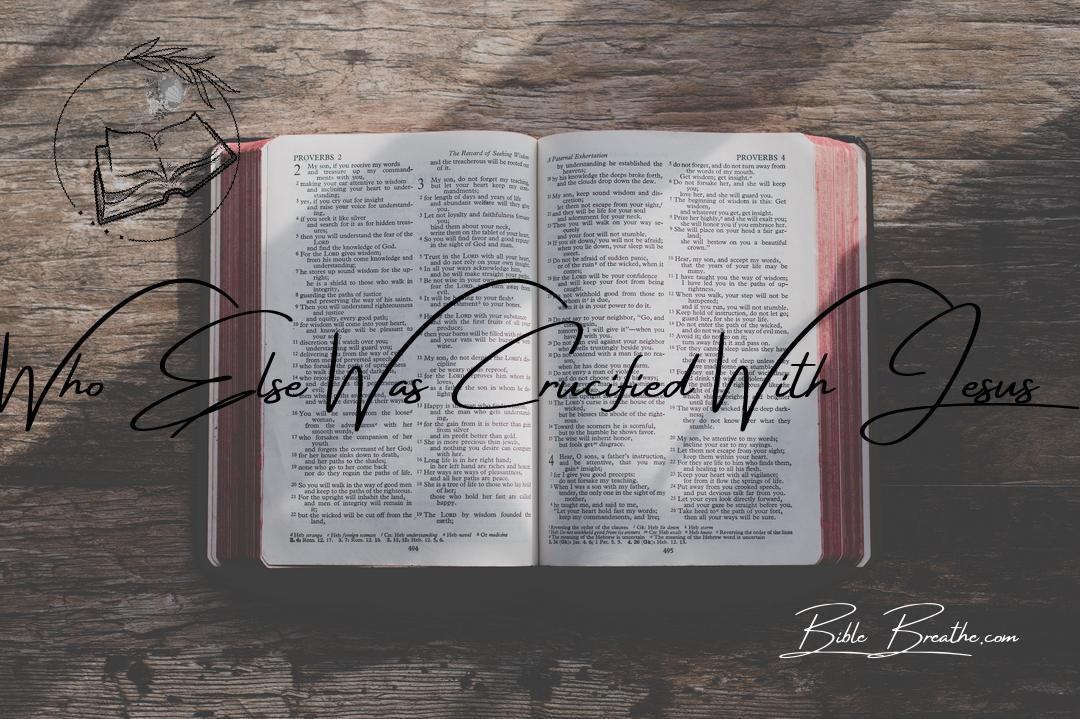Who hung on the crosses beside Jesus?
This ain’t just a historical account, folks, it’s a mind-blowing journey to Calvary.
Picture it: Gestas and Dismas, two dudes whose stories are like night and day.
Gestas, a no-regrets kinda guy, and then there’s Dismas, the ultimate game-changer.
He repents and finds salvation, showing us it’s never too late to turn things around.
Jesus, the Son of God, was right there in the middle, the ultimate game-changer.
This ain’t just a tale; it’s a lesson in redemption.
Let’s roll through this story of bad guys turned good, and remember, no matter where you’ve been, there’s always room for redemption and a shot at paradise.
Come, let’s dive into this life-changing story!
🙌✝️
Key Takeaways
-
Significance of the Two Thieves: The presence of the two thieves crucified alongside Jesus holds profound significance in the crucifixion narrative. They represent the stark contrast between belief and unbelief, repentance and defiance, and salvation and condemnation. Their inclusion highlights the universal nature of the gospel, offering hope to all, regardless of their past.
-
Moral Lessons from Their Stories: The stories of the two thieves offer valuable moral lessons. The repentant thief’s plea for salvation reminds us that it’s never too late to turn to God, even in our darkest moments. His faith and humility serve as a powerful example of true repentance and the assurance of salvation. Conversely, the unrepentant thief’s rejection of Christ serves as a cautionary tale about the consequences of unbelief and pride.
-
Enduring Relevance in Contemporary Times: The tales of the two thieves continue to be relevant in contemporary times. They remind us of the power of forgiveness, redemption, and the transformative impact of faith. In a world where people often struggle with guilt and shame, the story of the repentant thief offers hope and a reminder of God’s boundless grace.
-
A Call to Reflect and Respond: The stories of the two thieves invite us to reflect on our own lives. Are we open to God’s forgiveness and grace, like the repentant thief, or do we persist in unbelief and pride? They call us to respond with humility and faith, recognizing that, like the repentant thief, we can find forgiveness and eternal life through Christ.
-
The Cross as a Symbol of Redemption: The presence of the two thieves at the crucifixion underscores the redemptive nature of the cross. It symbolizes the opportunity for transformation and reconciliation with God. Their stories emphasize that the cross is not just an instrument of suffering but also a symbol of hope and salvation.
In summary, the stories of the two thieves crucified with Jesus offer profound moral lessons and continue to resonate with people today.
They highlight the power of faith, redemption, and God’s boundless grace, inviting us to reflect on our own response to Christ’s sacrifice on the cross.
The Cross’s Company: Who Shared the Painful Journey?
Photo modified by BibleBreathe.com. Original photo by Gary Fultz on Unsplash
When we talk about the crucifixion of our Lord, it’s more than just Him bearing that heavy cross.
On that somber day, two other souls faced their fate on the crosses too.
Let’s dive into the narrative of those two fellows crucified beside Jesus.
The Two Thieves: Let’s Meet Them
As the darkness loomed over Calvary, not just one but two souls bore the weight of crucifixion alongside Jesus.
These weren’t esteemed leaders or holier-than-thou individuals; they were everyday lawbreakers, facing the Roman cross’s unforgiving agony.
They went by the names Dismas and Gestas, and their roles in the drama of that day were significant.
Dismas, often dubbed as the “Good Thief,” is remembered for his change of heart and acknowledging Jesus as the Son of God.
On the flip side, Gestas held on to his defiance till the end.
These two contrasting figures paint a vivid picture of the choices we face in life.
“And he [Dismas] said unto Jesus, Lord, remember me when thou comest into thy kingdom. And Jesus said unto him, Verily I say unto thee, Today shalt thou be with me in paradise.” – Luke 23:42-43 (KJV)
Why It Matters
You might wonder, why bother knowing about these two thieves?
Their presence holds profound theological and moral significance.
It’s a powerful reminder that even in the direst circumstances, there’s room for redemption.
Dismas’ change of heart and his acceptance of Jesus bring hope, affirming that no matter how lost we might feel, salvation is within our grasp.
Their crucifixion alongside Jesus also fulfills the prophecy that he was “numbered with the transgressors.”
It symbolizes the ultimate sacrifice for the redemption of sinners, emphasizing the profound message of forgiveness and atonement.
So, the next time you reflect on the crucifixion, let these two thieves remind you of the eternal choice we all face between sin and salvation, darkness and light, and the boundless mercy of God.
The Crucified Trio: Jesus, Gestas, and Dismas
Photo modified by BibleBreathe.com. Original photo by Richard Stovall on Unsplash
In the epic tale of Jesus Christ‘s crucifixion, let’s shine a light on two characters who often dwell in the shadows.
Meet Gestas and Dismas.
They weren’t mere spectators at this crucible of destiny; they were right in the thick of it, playing pivotal roles in the grand narrative of salvation.
Who Were These Guys, Anyway?
Gestas and Dismas weren’t apostles or religious bigwigs; they weren’t famous scholars or holy men.
Nope, they were just two regular criminals facing the brutal Roman punishment of crucifixion.
Life had dealt them a hand that led to this hill, each with their own tales of wrongdoing.
The Names Speak Volumes
You know, in the Bible, names often carry a deeper meaning.
And Gestas and Dismas are no exception.
Dismas, sometimes called the “good thief,” had a moment of redemption at the foot of the cross.
His name, interestingly, may echo the word ‘dimos,’ which means ‘popular’ or ‘the people.’ Meanwhile, Gestas, the unrepentant one, has a name associated with ‘gestas,’ signifying ‘deeds’ or ‘exploits,’ quite fitting for his defiant nature.
In the Gospel of Luke, we see Dismas as the thief who, in his final breaths, acknowledged Jesus as the Son of God and sought salvation, saying:
“And he said unto Jesus, Lord, remember me when thou comest into thy kingdom.” – Luke 23:42 (KJV)
Gestas, on the other hand, clung to his rebellion.
The Art and Stories of “Saint Dismas the Good Thief”
The stark contrast between these two thieves has inspired countless artists and writers.
Dismas, often depicted with a look of remorse and hope, serves as a symbol of redemption’s possibility.
He reminds us that salvation is a lifeline available to every sinner, no matter how dark their past.
The crucifixion of Jesus wasn’t just about Him; it had profound meaning for those crucified beside Him.
In the tug-of-war between Gestas and Dismas, we witness the eternal battle between pride and humility, rebellion and repentance.
It’s a battle that resonates through the annals of history, challenging us to reflect on our own journeys of redemption.
The Company on the Cross
Photo modified by BibleBreathe.com. Original photo by John Canada on Unsplash
Now, let’s take a stroll back in time to when crucifixion was the talk of the town, a harsh penalty reserved for the most serious wrongdoers.
We’re about to uncover the story of who hung alongside our Savior on that fateful day.
A Rare Sight in Rome
Crucifixion was no casual affair in ancient Rome.
It wasn’t a punishment they dished out like a daily special; it was the nuclear option of penalties.
The Romans used it to make a point, a stark warning to anyone even thinking about crossing the line.
Sorting Out the Culprits
On the day of Jesus’ crucifixion, he had two unexpected companions, often dubbed as mere thieves.
But these weren’t your everyday burglars swiping wallets; they were a different breed.
These fellows were branded as bandits, insurgents challenging the Roman grip on power.
Political Punctuation
Now, here’s the twist in the tale: it wasn’t a coincidence that Jesus found himself sandwiched between these two.
It was a calculated move with political undertones.
One of them, the unapologetic Gestas, didn’t hold back his scorn for Jesus.
The other, the repentant Dismas, saw the light and recognized Christ’s innocence and divinity.
This contrast, my friends, is a neon sign pointing to the heart of the Gospel story – repentance and salvation.
“And Jesus said unto him, Verily I say unto thee, Today shalt thou be with me in paradise.” – Luke 23:43 (KJV)
So, in the midst of that gruesome scene, Jesus’ crucifixion wasn’t just a tragedy; it was a game-changer.
It wasn’t just about the cross, nails, and thorns; it was about redemption and the salvation of humanity.
A Tale of Two Choices: The Crucified Companions
Photo modified by BibleBreathe.com. Original photo by Worshae on Unsplash
Picture this scene on Golgotha hill – it’s a canvas of contrasting reactions, a snapshot of humanity’s complex beliefs and doubts.
Dismas: A Heartfelt Plea for Salvation
Amidst the agony of crucifixion, Dismas, one of the condemned thieves, had a transformation of heart.
As the weight of his sins and the reality of his impending death bore down on him, he let go of his pride.
Turning to Jesus, the crucified Messiah, he made a heartfelt plea for salvation:
“And he said unto Jesus, Lord, remember me when thou comest into thy kingdom.” – Luke 23:42 (KJV)
In that moment, he saw the divinity in the one hanging beside him.
He acknowledged his own wrongdoings and asked for forgiveness.
His words weren’t laced with bitterness or defiance; instead, they were a humble recognition of Jesus’ true identity.
Gestas: Taunts and Rejection
Now, on the flip side, there’s Gestas, the other thief.
He clung stubbornly to his pride and rebellion.
Even as the pain of crucifixion seared through him and the divine was right there, he chose to mock and taunt Jesus:
“If thou be Christ, save thyself and us.” – Luke 23:39 (KJV)
Gestas’s response showcased a heart unwilling to yield, a soul resistant to the possibility of redemption.
He held onto disbelief, even in the presence of the profound love displayed by the crucified Savior.
Contrasting Destinies
After that fateful day, the destinies of these two thieves couldn’t have been more different.
Dismas, despite a life filled with wrongdoing, found redemption through his faith.
Jesus assured him:
“Verily I say unto thee, today shalt thou be with me in paradise.” – Luke 23:43 (KJV)
But Gestas faced a fate of eternal separation from grace, a destiny sealed by his disbelief and refusal to see the salvation within his reach.
Remember, the crucifixion wasn’t just a physical event; it was a spiritual crucible where hearts were laid bare, choices were made, and destinies were sealed.
It serves as a timeless reminder that in the face of profound suffering and impending judgment, our response – whether it’s one of humility or pride – can shape our eternity.
Lessons Carved in the Cross
Photo modified by BibleBreathe.com. Original photo by Aysegul Yahsi on Unsplash
As we gather around the foot of that rugged hill called Calvary, we’re not just spectators to a historical drama; we’re peering into a treasure chest of timeless truths etched in the crucifixion of Jesus and his companions, Gestas and Dismas.
Pain vs. Transformation
Both Gestas and Dismas felt the excruciating sting of those cross beams, but their responses couldn’t have been more different.
Gestas, the unyielding rebel, clung to his bitterness even as death loomed large.
He endured the physical agony but let his heart remain stone cold.
In contrast, Dismas, the repentant soul, though wracked by the same pain, saw the light.
He owned up to his deeds and begged for forgiveness.
In his suffering, he found a path to spiritual transformation.
Timeless Truths
These tales aren’t confined to dusty history books; they reverberate through the ages.
They paint a vivid picture of the clash between stubborn pride and genuine remorse.
Gestas embodies the refusal to admit wrongdoing, a journey towards spiritual desolation.
Dismas, on the other hand, embodies hope and renewal.
His humility, his acceptance of guilt, and his plea for forgiveness remind us that no matter how shadowed our past, sincere repentance can lead us back into the arms of divine mercy.
“And he said unto Jesus, Lord, remember me when thou comest into thy kingdom.” – Luke 23:42 (KJV)
Lessons for Today
In our warp-speed modern lives, we can still glean wisdom from that old crucifixion scene.
It beckons us to take stock of our own responses to suffering and repentance.
Are we, like Gestas, stubbornly resistant to change, unyielding in our pride?
Or are we willing to admit our wrongs, like Dismas, and seek redemption?
Our choices in this journey can steer us toward spiritual desolation or the limitless grace of salvation.
Let the stories of Gestas and Dismas be our guiding stars, reminding us that even in our darkest hours, redemption waits, and a brighter tomorrow beckons.
Lessons from the Crucifixion: Teaching Values to the Young
Photo modified by BibleBreathe.com. Original photo by Tim Wildsmith on Unsplash
In the solemn shadows of Golgotha, where Christ and two fellow travelers faced crucifixion, lies a story that’s not just for the faithful but a profound lesson for parents and teachers who are on a mission to instill empathy and wisdom in the hearts of the young.
The Power of Understanding and Repentance in Child-Rearing
The tale of Dismas and Gestas shines a light on a vital aspect of shaping a child’s moral compass: understanding and repentance.
Dismas, by recognizing Jesus as the Son of God and humbly seeking salvation, shows us the incredible strength of admitting our wrongs and seeking forgiveness.
This isn’t just a story from ancient times; it’s a shining example for parents, illustrating the importance of instilling a sense of responsibility and accountability in our kids.
Using Stories to Teach Moral Values
This narrative becomes a powerful tool in teaching children about the consequences of their actions.
The different choices made by the two thieves teach us that even in the darkest moments, our decisions shape our destinies.
By sharing this story, parents and teachers can impart valuable lessons in humility, repentance, and the belief that redemption is always within reach.
Through guided discussions and reflections on Dismas and Gestas, children can learn about empathy, the cost of pride, and the significance of acknowledging and making amends for our mistakes.
The crucifixion story, with all its layers of meaning, can ignite a spark in young hearts, helping them understand that even in the face of challenges, they have the power to choose the path of goodness and transformation.
As parents and teachers, we’re not just responsible for passing on knowledge; we’re also shaping character.
The crucifixion story, with its deep portrayal of human nature, gives us a compelling tool to nurture empathy, kindness, and a strong moral compass in the hearts of the young.
Frequently Asked Questions (FAQs) About Who Else Was Crucified With Jesus
Who were the two men crucified with Jesus?
The two men crucified alongside Jesus were criminals.
One, traditionally named Dismas, repented and found salvation, while the other remained unrepentant.
This event symbolizes the possibility of redemption even in the most dire circumstances.
Why were they crucified alongside Jesus?
The two individuals crucified alongside Jesus were criminals, and their crucifixion served as a form of punishment for their crimes.
One of them, traditionally known as the ‘penitent thief,’ expressed faith in Jesus while on the cross and received assurance of salvation from Him (Luke 23:39-43).
Their presence alongside Jesus during His crucifixion fulfilled the prophecy and demonstrated His identification with sinners.
What did Jesus say to the thieves during the crucifixion?
Jesus spoke words of assurance and promise to one of the thieves, assuring him of paradise: ‘Truly, I say to you, today you will be with me in paradise’ (Luke 23:43).
He showed mercy and grace, offering salvation even at the last moments of life.
{
“@context”: “https://schema.org”,
“@type”: “FAQPage”,
“mainEntity”: [
{
“@type”: “Question”,
“name”: “Who were the two men crucified with Jesus?”,
“acceptedAnswer”: {
“@type”: “Answer”,
“text”: “The two men crucified alongside Jesus were criminals. One, traditionally named Dismas, repented and found salvation, while the other remained unrepentant. This event symbolizes the possibility of redemption even in the most dire circumstances.”
}
},
{
“@type”: “Question”,
“name”: “Why were they crucified alongside Jesus?”,
“acceptedAnswer”: {
“@type”: “Answer”,
“text”: “The two individuals crucified alongside Jesus were criminals, and their crucifixion served as a form of punishment for their crimes. One of them, traditionally known as the ‘penitent thief,’ expressed faith in Jesus while on the cross and received assurance of salvation from Him (Luke 23:39-43). Their presence alongside Jesus during His crucifixion fulfilled the prophecy and demonstrated His identification with sinners.”
}
},
{
“@type”: “Question”,
“name”: “What did Jesus say to the thieves during the crucifixion?”,
“acceptedAnswer”: {
“@type”: “Answer”,
“text”: “Jesus spoke words of assurance and promise to one of the thieves, assuring him of paradise: ‘Truly, I say to you, today you will be with me in paradise’ (Luke 23:43). He showed mercy and grace, offering salvation even at the last moments of life.”
}
}
]
}







